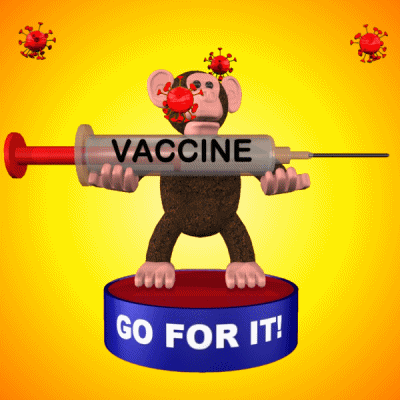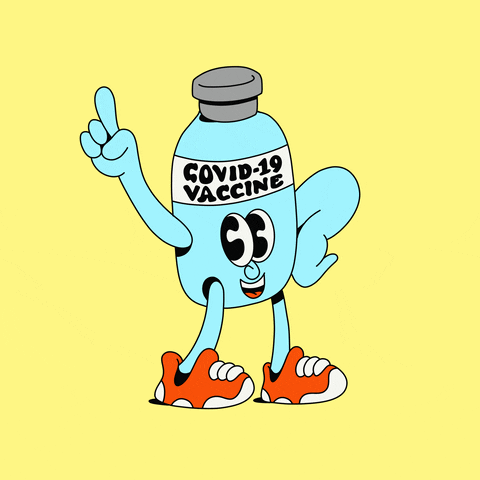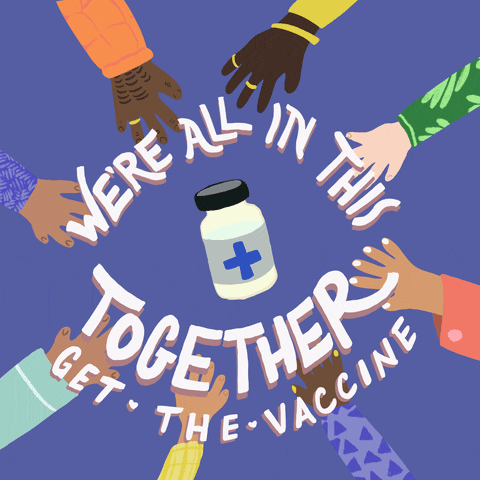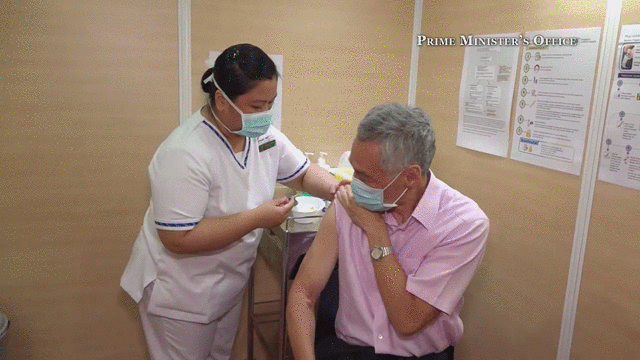
Brave the Vaccine!
by Kenneth Lyen

GETTING THE INJECTION
Recently I received the Pfizer-BioNTech vaccine. The nurse counted down 3-2-1 and I closed my eyes as she gave me the jab. It was painless. Then I waited outside the room for 30 minutes in case of any severe allergic reactions. There were none. I registered to return in three weeks' time to receive my second vaccine dose.
Eight hours after the injection, I felt a slight ache in the arm and when I examined the injection site, there was only the red mark of the needle entry and no bruising or swelling. I felt warm but when I checked my temperature it was 36.8C. I was otherwise totally asymptomatic. Phew!
My colleagues who also had the needle sliding into their deltoids also complained of arm pain. Some had fever, tiredness, headaches, dizziness, feeling chills and shaking with cold, which lasted for a day or two. Fortunately, nobody I know had any severe allergic reactions.
I received the second dose of the vaccine three weeks after the first. The reaction was the same as the first: just a transient pain at the injection site that lasted less than a day. No other side effects.


EARLY HISTORY OF THE COVID-19 VACCINES
Like many kiasu doctors, I did some background reading of the different vaccines before accepting this vaccine. It is true that the COVID-19 vaccine was achieved in record time, under one year. Some say this was too rushed, and point to some severe reactions (1). There are two aspects to vaccine development: first is the laboratory research and animal tests, and second is the clinical trials (2).
Focusing on the laboratory virus research first. The first coronavirus was identified in 1965, but vaccine development did not start until the first epidemic of Severe Acute Respiratory Syndrome (SARS) in 2003 Unfortunately research stalled because the outbreak evaporated within a year. The same thing happened again with the Middle East Respiratory Syndrome (MERS) coronavirus outbreak in 2012 (3). Singapore and other countries joined in the vaccine research, and once again the outbreak subsided and vaccine research was suspended, never progressing to clinical trials.

KATALIN KARIKO and DREW WEISSMAN
Groundbreaking research was conducted initially without any connection to the vaccine, but later emerged to become the foundation of the current messenger RNA (mRA) vaccine. Notable is the work of Katalin Kariko and Drew Weissman, who jointly developed the ability to translate mRNA into predetermined proteins and to insert the mRNA into cells. The history of Kariko's work is tantalizing (4). In the 1980s she joined the University of Pennsylvania and proposed that mRNA could be used not only to fight diseases but also for vaccine development. Sadly, the university consistently rejected her unorthodox ideas and her research grant applications were consistently rejected. Luckily Kariko's colleague Drew Weissman believed in her ideas and collaborated with her. In 1995 the university even demoted her from her academic position, and at the same time she was diagnosed with cancer. However, she did not resign from her position, and she persevered with her research which she published in 2005. Eventually her prescient ideas of an mRNA vaccine was recognised by others, and later by two pharmaceutical companies, BioNTech which later joined up with Pfizer, and Moderna.

MECHANISMS OF ACTION OF DIFFERENT VACCINES (Table 1) (5,6)
1. mRNA VACCINES (Pfizer-BioNTech, Moderna, Singapore Arcturus)
The basic idea here is to write a special coded message in the mRNA that is presented to the ribosome which will then translate the message to manufacture the desired protein antigen; in this case that immune stimulating antigen happens to be the spike protein found on the COVID-19 virus. Katalin Kariko’s contributions were several. Firstly, she produced a lipid nanoparticle coat that enables the mRNA to penetrate the cell membrane of the macrophages and dendritic cells found close to the injection site. Secondly, she discovered exactly how to rewrite the mRNA to give a precise instruction for the cell to produce the immunogenic protein. Together with Drew Weissman, she helped develop the highly effective mRNA vaccine against COVID-19.
The advantages of using mRNA are several. No virus is used, so one will not come down with COVID-19.The vaccine mRNA does not enter the cell nucleus and therefore cannot affect the genetic material inside the nucleus.

Pfizer-BioNTech and Moderna adopted this vaccination technique, and each completed a phase 3 double-blind placebo-controlled trial, and by December 2020, they confirmed its safety with minimal side effects, and achieved 95% efficacy (see Table 1). The US Food and Drug Administration quickly gave emergency approval. The Pfizer-BioNTech vaccine needs to be stored below -70°C, and the second dose is given 3 weeks later (7), while the Moderna vaccine has to be stored at -20°C, with the second dose given 4 weeks later (8).

2. WEAKENED VIRUS INSERTED INTO ANOTHER VIRAL VECTOR (Oxford-AstraZeneca, Cansino, Gamaleya's Sputnik V)
The use of the adenovirus as a vector to help insert the genetic material of a virus vaccine into a cell has previously been employed for measles, ebola, zika, and human immunodeficiency (HIV) vaccines. The adenovirus DNA is first removed, leaving an emptied protein coat or capsid. This is then filled with the intended SARS-CoV-2 virus which has been weakened or inactivated. The adenovirus capsid helps insert the inactivated coronavirus into the cells, thus mimicking a viral infection (9).
Oxford-AstraZeneca chose to use a chimpanzee adenovirus as its vector. What are the side effects? In an editorial published in November 2020 issue of Cell, the adenovirus-based vaccine adverse effects include "fever, pneumonia, diarrhea, transient neutropenia and lymphopenia, fatigue, labored breathing, headaches, liver damage, and fasting hyperglycaemia. Rare but grave adverse reactions include neuropathies such as Bell’s palsy, Guillain-Barré syndrome, gait disturbance, and transverse myelitis, an inflammatory condition in the spinal cord." So far, the Oxford-AstraZeneca trial results show 70% efficacy (10), and the Russian Sputnik V vaccine which uses the same technique, is said to be 91.4% effective (11). Both vaccines need be stored between 2°-8°C.
3. DOUBLE STRAND DNA INSERTED INTO ADENOVIRUS (Janssen J&J)
Johnson and Johnson’s vaccine differs from other vaccines in that it uses DNA and not RNA. A doubled strand of DNA is inserted via an adenovirus vector. The DNA enters the cell’s nucleus, and it carries instructions to manufacture a special nonviral mRNA which in turn translates the instructions to manufacture the spike protein of the coronavirus. The other difference of this vaccine is that it only requires a single dose. The vaccine is undergoing phase 3 clinical trials, and to date the efficacy is between 57-72%. It is stored between 2° to 8°C.

4. WEAKENED INACTIVE VACCINES INJECTED DIRECTLY (SinoPharm, Sinovac Coronavac, Bharat Biotech Covaxin)
The Salk polio vaccine, most influenza vaccines, and the hepatitis A vaccine, use the technique of inactivating the virus which is then injected directly into the subject. This technique has been employed in two of the China-produced vaccines, SinoPharm and Sinovac’s Coronavac (13), and India’s Bharat Biotech’s Covaxin (14), These “killed” virus vaccines can be stored between 2° to 8°C. Some commentators are uncertain about the efficacy and side effects of these vaccines.

5. SUBUNIT VACCINES (Novavax)
This vaccine takes a purified piece of the spike protein from the surface of the SARS-CoV-2 virus, and an adjuvant which enhances the immunogenicity of the vaccine protein is added to it. Both the spike protein and the adjuvant are injected into the subject. So far, the immune response in terms of antibody production as well as increased T-cells, have been promising. However, to date, phase 3 trial data have not been released. The Novavax can be stored between 2°-8°C (12).



VACCINE HESITANCY
Many people have a fear of needles stemming from medical injections over the years. Compounded by over-dramatized information, such as anaphylactic shock and deaths following vaccinations, there is a reluctance for some people worldwide to voluntarily accept the vaccines. Most of these severe side effects and deaths have been shown to be unrelated to the vaccine (15).

Severe allergic reactions to the vaccine do occur, but they are very rare, and are found in those who have a past history of severe allergic responses (16,17). Hence those who have a history of such reactions are advised not to take the vaccine. These severe responses usually occur within 15 minutes of the vaccination, and therefore, as an additional precaution, vaccinated subjects are observed for 30 minutes after the injection.
Even in Singapore, a survey conducted on 23 January 2021 showed that only 60% are willing to accept the free vaccination offered by the government (18). Perhaps Singapore may be a victim of its own success (19). Fortunately the vaccination rate has improved. It has famously flattened the infection curve and reduced the local spread to less than 5 per day, sometime zero cases. The total death rate has slowly crept up to 46, which contrasts with the thousands of daily deaths in most other countries. This has led some Singaporeans to believe that since there are virtually no locally transmitted cases of COVID-19, then what is the benefit of getting vaccinated? (20)
The answer is that while Singapore may be doing well In controlling the spread of coronavirus, the world is still teeming with millions of cases. Travelers to Singapore will inevitably bring some of the virus to our country. There is another potential problem, namely new mutations. They spread much more quickly, but luckily the vaccines seem to provide some degree of protection to these new variants.

NEW MUTATIONS
New mutations of the SARS-CoV-2 virus have been discovered in the UK, Brazil, South Africa (21), and India. They have been found to be highly infective probably due to better binding of the virus to the Angiotensin Converting Enzyme 2 (ACE2) receptor, which increases a person’s susceptibility to the virus. Anthony Fauci, the director of the National Institutes of Allergy and Infectious Diseases has stated that the British new mutant variant is more deadly than the original virus (23).

At the moment, the current Pfizer and Moderna vaccines seem capable of stimulating a vaccinated person’s antibodies to neutralize the invading mutant variants (24,25).

Professor Ooi Eng Eong of the Duke-NUS Medical School told the Straits Times that “Singaporeans need not worry about the mutations being reported or the possibility of having to alter the vaccine in the near term (26).
But we cannot sit on our derrieres. Although virologists believe it is less likely, it is not impossible in the future for a virus to mutate into a new strain which is resistant to the current vaccines.

FINAL THOUGHTS
At the time of writing, we do not know how long the vaccines are effective because the clinical trials were only started in middle of 2020. Nor do we know how effective the vaccines are against the new mutant variants of the coronavirus.
The vaccine is probably our best chance of controlling the pandemic. By taking the vaccine, you become immune to the SARS-CoV-2 virus, which means that not only will you be protected, but you will not transmit it to others. If more than 80% if the population is protected, then this is effective herd immunity. Singapore, UAE, and Malta are the first to achieve this target. The next countries to reach 80% vaccination of the population are Bahrain, Uruguay, Qatar, Chile, Denmark, Canada and Israel.
In the meantime, please continue to wear masks, observe social distancing, and keep clean.

The benefits of the vaccine will trump (sorry Donald) the side effects. My advice is: “Go for it!”



How Long Will the Pandemic Last?


REFERENCES
1 The rush to create a COVID-19 vaccine may do more harm than good,
https://www.bmj.com/content/370/bmj.m3209
2 Coronavirus vaccine development: from SARS and MERS to COVID-19
https://jbiomedsci.biomedcentral.com/articles/10.1186/s12929-020-00695-2
3 Learning from the past: development of safe and effective COVID-19 vaccines
https://www.nature.com/articles/s41579-020-00462-y
4 The story of mRNA: How a once-dismissed idea became a leading technology in the Covid vaccine race
5 New York Times Coronavirus Vaccine Tracker: https://www.nytimes.com/interactive/2020/science/coronavirus-vaccine-tracker.html
6 Comparing vaccines:
https://www.nature.com/articles/s41591-021-01230-y
7 Pfizer-BioNTech vaccine trial results: https://www.nejm.org/doi/full/10.1056/NEJMoa2034577
8 Moderna vaccine trial results: https://www.nejm.org/doi/full/10.1056/NEJMoa2035389
9 Vector-Based Vaccines Come to the Fore in the COVID-19 Pandemic
https://www.the-scientist.com/news-opinion/vector-based-vaccines-come-to-the-fore-in-the-COVID-19-pandemic-67915
10 Oxford AstraZeneca vaccine trial results: https://www.thelancet.com/journals/lancet/article/PIIS0140-6736(20)32661-1/fulltext
11 Sputnik V vaccine trial results: https://sputnikvaccine.com/newsroom/pressreleases/second-interim-analysis-of-clinical-trial-data-showed-a-91-4-efficacy-for-the-sputnik-v-vaccine-on-d/
12 Novavax Advances Development of Novel COVID-19 Vaccine
https://ir.novavax.com/news-releases/news-release-details/novavax-advances-development-novel-COVID-19-vaccine
13 Sinovac: Brazil results show Chinese vaccine 50.4% effective
https://www.bbc.com/news/world-latin-america-55642648
14 Bharat Biotech Covaxin effectiveness: https://science.thewire.in/health/COVID-19-bharat-biotechs-covaxin-expected-to-be-60-effective-company-says/
15 Pfizer Vaccine Safe for Elderly Despite Norway Scare, WHO Says
16 Allergic Reactions Including Anaphylaxis After Receipt of the First Dose of Pfizer-BioNTech COVID-19 Vaccine
https://www.cdc.gov/mmwr/volumes/70/wr/mm7002e1.htm
17 Anaphylaxis Cases With Moderna COVID-19 Vax Follow Similar Pattern
https://www.medpagetoday.com/infectiousdisease/covid19/90839
18 Sixty percent of Singaporeans uncertain of taking up COVID-19 vaccine: https://www.asiaone.com/singapore/60-singapore-residents-polled-still-uncertain-about-taking-COVID-19-vaccination
19 Coronavirus: could Singapore’s vaccine drive become a victim of the city’s own success?
20 Benefits of COVID-19 Vaccine
https://www.mayoclinic.org/diseases-conditions/coronavirus/in-depth/coronavirus-ts
21 New COVID-19 Variants
https://www.cdc.gov/coronavirus/2019-ncov/transmission/variant.html
22 Researchers in Singapore discover new SARS-CoV-2 variant that causes less severe infections
23 Anthony Fauci: new variant of SARS-CoV-2 more deadly than original:
https://nypost.com/2021/01/24/fauci-warns-uk-strain-now-appears-to-be-more-deadly/
24 Pfizer and Moderna vaccines still effective against new mutant variants of SARS-Cov-2 virus: https://www.nytimes.com/2021/01/20/health/coronavirus-variants-immunity.html
25 Vaccines likely still effective against new variants: https://www.straitstimes.com/singapore/health/vaccines-likely-still-effective-against-new-variants-say-experts
26 Ooi Eng Eong: Current vaccines likely still effective for new COVID-19 mutations
27 COVID-19 vaccine and you
https://www.straitstimes.com/singapore/COVID-19-vaccine-and-you-what-to-expect
28 Covid-19 Vaccines talk by Dr Leong Hoe Nam. The sound starts off a bit soft but gets louder after a couple of minutes. https://www.youtube.com/watch?v=QN0hpIlg6Gg
29 The Vaccine Quest part 1: Channel NewsAsia: https://www.mewatch.sg/watch/The-Vaccine-Quest-E1-Part-One-204284
30 Brave the Vaccine! https://www.sma.org.sg/UploadedImg/files/Publications%20-%20SMA%20News/5305/Opinion.pdf
Kenneth Lyen
29 Jan 2021, updated 19 August 2021
.jpg)

